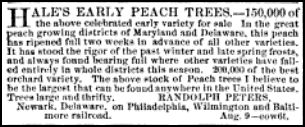 |
| Possibly Randolph Peters' House |
I had actually intended to do a post about the house seen above, which is located on the south side of Old Paper Mill Road, about a half mile east of Paper Mill Road. Old Paper Mill Road once connected all the way over to Possum Park Road, right where Old Possum Park Road now joins up with the rerouted road. Although this house certainly dates to at least the early 1800's, I wasn't able to find much about it in a quick search -- at least not before I was sidetracked into a different direction. Once I looked through the census and discovered who the "R. Peters" was who was listed below the Fruitland Nursery, it all fell into place.
The name on the map was Randolph Peters (1822-1885), who was born in Pennsylvania, but moved from New Jersey to the Newark area in 1857. He, along with his wife, Sarah, and four children, settled on a farm east of the Curtis Paper Mill and began the cultivation of fruit. It's not clear which house they lived in, although the one above was certainly there at the time and appears to be the only one close that's included on both the 1849 and 1868 maps. By 1868, there are three houses listed for Randolph, and one for his son William. (Presumably, two, or probably by that time, all three of Randolph's, were used by workers in the orchards.) By this time, though, Peters had greatly expanded his business operation.
After only four apparently peachy years (sorry) of growing fruit trees (specializing in pear and peach trees), Randolph Peters bought another property a couple miles south of Wilmington, where in 1861 he established the Great Northern and Southern Garden and Nursery. I'm not quite as familiar with the area over there in New Castle Hundred, but as best as I can tell, Peters' nursery was in Minquadale, about where Gracelawn Cemetery is now. He moved his family over there after buying the property, and the Minquadale location seems to be his primary location after that.
Peters continued to grow his business until his death in 1885. After that, his family held on to the nursery for a few years, but by the late 1890's the New Castle Hundred property had been sold to a man named Paul Gillis. As to the MCH property, the 1893 map shows the house on the south side of the road as belonging to what looks like L. McCormack. The property north of the road appears to say "Estate S.C. Peters". Presumably this means Randolph's widow Sarah A. C. Peters, and the estate must refer to him, since she was very much alive. In 1900, Sarah was living in Cheswold, Kent County with her youngest daughter Georgie and son-in-law Joseph Smith.
The only other mentions I can find to this property are several like this one, which notes that the estate was used by the University of Delaware in the late 1880's and early 1890's for experiments in different crop treatments. Oddly, these list it as belonging to the Randolph Peters Nursery Company, but these are the only references to that business name I could find. One report specifically states that it has, "one of the oldest, largest, and best pear orchards in the state." Interesting to know that such an orchard once sat right outside of Newark, in the far corner of Mill Creek Hundred.

